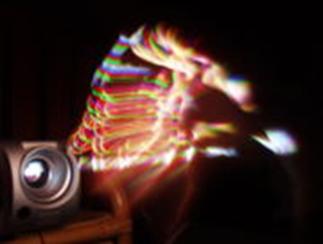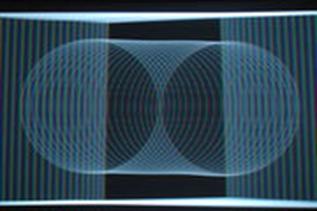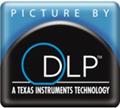 Go Back Go Back
 Print Page Print Page
DLP Projector vs. LCD Projector
LCD Projector
An LCD projector is a device utilized for displaying video images or data. It is the modern equivalent to the slide projector and overhead projector used in the past.
LCD (liquid crystal display) projectors usually contain three separate LCD glass panels, one each for the red, green, and blue components of the video signal. Light from a halogen lamp, which outputs an ideal color temperature and a broad spectrum of color is split by a prism into the three component colors. As light passes through the LCD panels, individual pixels can be opened to allow light to pass, or closed to block the light, as if each little pixel were fitted with a Venetian blind. This activity modulates the light and produces the image that is projected onto the screen.
With a lens that "projects" the image on any flat surface and does not require large "furniture" (like a big TV would), LCD projectors tend to be smaller and much more portable than older systems. The best image quality can be accomplished with a blank white or grey surface to project on, and for this reason dedicated projection screens are often used.
Early systems were often intended to be used with existing overhead projectors, built as a large "plate" that was put on the projector in place of the transparencies. This provided the market with a stop-gap solution in the era when the computer was not yet the universal display medium.
This technology is employed in some sizes of rear projection television consoles, as there are cost advantages when employed in mid size sets (40 to 50 inch diagonal). This is not expected to have much longevity in the "home theater" marketplace due to expected improvements cost/performance of competing technologies, particularly in direct-view LCD panels at the lower range of sizes and DLP projection in the larger sizes.
In 2004 and 2005, LCD front projection has been enjoying a come-back because of the addition of the dynamic iris which has improved perceived contrast up to the levels of DLP.
In early 2006 three-panel LCD projectors were significantly cheaper than three-chip DLP projectors. In part because of the rainbow effect three chip/panel projectors are considered better than single chip/panel projectors for TV and home cinema.
The basic design of an LCD projector is frequently used by hobbyists who build their own HDTV projection systems. The basic technique is to combine a high CRI HID lamp and ballast with a condenser and collector fresnel, an LCD removed from a common computer display and a triplet.
 DLP Projector DLP Projector
Digital Light Processing (DLP) is a technology used in projectors and video projectors. It was originally developed at Texas Instruments, in 1987 by Dr. Larry Hornbeck.
In DLP projectors, the image is created by microscopically small mirrors laid out in a matrix on a semiconductor chip, known as a Digital Micromirror Device (DMD). Each mirror represents one pixel in the projected image. The number of mirrors corresponds to the resolution of the projected image. 800x600, 1024x768, 1280x720, and 1920x1080 (HDTV) matrices are some common DMD sizes. These mirrors can be repositioned rapidly to reflect light either through the lens or on to a heatsink (called a light dump in Barco terminology).
The rapid repositioning of the mirrors (essentially switching between 'on' and 'off') allows the DMD to vary the intensity of the light being reflected out through the lens, creating shades of grey in addition to white (mirror in 'on' position) and black (mirror in 'off' position).
Color in DLP projection
There are two primary methods by which DLP projection systems create a color image, those utilized by single-chip DLP projectors, and those used by three-chip projectors.
1. Single-chip Projectors
In a projector with a single DMD chip, colors are produced by placing a color wheel between the lamp and the DMD where it is reflected out through the optics. The color wheel is usually divided into four sectors: the primary colors: red, green, and blue, and an additional clear section to boost brightness. Since the clear sector reduces color saturation, in some models it may be effectively disabled, and in others it is omitted altogether.

The Rainbow Effect – Live!
The DMD chip is synchronized with the rotating motion of the color wheel so that the green component is displayed on the DMD when the green section of the color wheel is in front of the lamp. The same is true for the red and blue sections. The red, green, and blue images are thus displayed sequentially at a sufficiently high rate that the observer sees the composite "full color" image. In early models, this was one rotation per frame. Later models spin the wheel at two or three times the frame rate, and some also repeat the color pattern twice around the wheel, meaning the sequence may be repeated up to six times per frame.
The DLP "Rainbow Effect"

This visual artifact is best described as brief flashes of perceived red, blue, and green "shadows" observed most often when the projected content features bright/white objects on a mostly dark/black background (the scrolling end credits of many movies being a common example). Some people perceive these rainbow artifacts all of the time, while others say they only see them when they let their eyes pan across the image. Yet others do not notice the artifact at all. The effect is likely rooted in the concept of the flicker fusion threshold.
The image to the right shows how a white circle looks to a camera while panning horizontally, using a long exposure. The white light is visibly split into its colored components. The rainbow effect occurs when this is visible to the naked eye. The multiple images of the circle represent the individual frames of video, and are unrelated to the rainbow effect.
The "Rainbow Effect" is unique to single chip DLP projectors. Since a single chip DLP projector uses a color wheel, as described above, only one color is actually displayed at any given moment. As the eye moves across the projected image, these separate colors become visible, resulting in a perceived "rainbow". The manufacturers of single-chip DLP projection systems use color wheels rotating at higher speeds, or with more color segments in order to minimize the appearance of the artifacts. These are referred to as 2x, 3x or 4x wheels. For example, a six segment wheel(RGBRGB) rotating at 2x speed would be a 4x wheel. Another way is to replace a segmented wheel with a wheel whose colors are in an archimedian spiral. This forms bands of color that move down (or up) the screen. Normally with segmented wheels there is a pause between colors while the wheel transitions from one color to another. This means the more segments there are, the darker the display will be (all else being equal). With a spiral wheel the mirrors can display more than one color at a time, each moving down (or up) as the wheel turns.
2. Three-chip Projectors
A three-chip DLP projector uses a prism to split light from the lamp, and each primary color of light is then routed to its own DMD chip, then recombined and routed out through the lens. Single-chip DLP systems are capable of displaying 16.7 million (24-bit) colors, whereas three-chip DLP systems can display up to 35 trillion colors.
Manufacturers and Market Place

Texas Instruments remains the primary manufacturer of DLP technology, which is used by many licensees who market products based on T.I.'s chipsets. The Fraunhofer Institute of Dresden, Germany, also manufactures Digital Light Processors, termed Spatial Light Modulators, for use in specialized applications. For example, Micronic Laser Systems of Sweden utilizes Fraunhofer's SLMs to generate deep-ultraviolet imaging in its Sigma line of silicon mask lithography writers.
DLP is rapidly becoming a major player in the rear-projection TV market, having sold two million systems and achieved a 10% market share. Over 50 manufacturers offered models during the 2004 holiday season, up from 18 the previous year. DLP chips currently constitute 5% of Texas Instruments' total sales. Small standalone projection units (also called front projectors) using DLP technology have become very popular for office presentation and home theater duties.
Pros and Cons
Pros:
- Smooth (at 1080p resolution), jitter-free images.
- Perfect geometry and excellent grayscale linearity achievable.
- Usually great ANSI contrast.
- No possibility of phosphor burn-in.
- Less "screen door effect" than with LCD projectors.
- DLP rear projection TVs are smaller, thinner, and lighter than CRT projectors.
- Use of a replaceable light source means a potentially longer life than CRTs and plasma displays.
- The light source is more-easily replaceable than the backlights used with LCDs, and is often user-replaceable.
Cons:
- In single-chip designs, some viewers are bothered by the "rainbow effect," explained above.
- Not as thin as LCD or plasma displays (although approximately comparable in weight).
- Fan noise.
- "Screen door effect" (SDE) may be visible at close distance and/or with lower resolution models (720p resolution and lower). SDE can also be perceived as artificially sharp looking (due to dark gaps between mirrors/pixels which are high frequency content, not part of the image displayed) and not film-like.
- Dithering noise may be visible, especially in dark image areas. Newer chip generations have less noise than older ones.
- Error-diffusion artifacts caused by averaging a shade over different pixels, since one pixel cannot render the shade exactly.
- The picture dims as the lamp deteriorates with age.
- Mediocre on-off contrast compared to CRT reference.
- Response time in video games may be affected by upscaling lag. While all HDTVs have some lag when upscaling lower resolution input to their native resolution, DLPs are commonly reported to have noticably longer delays. Newer consoles such as the Xbox 360 and Playstation 3 do not have this problem as long as they are connected with HD-capable cables. (Samsung's newer TV's have a "game mode" which is supposed to reduce the lag by not doing as much processing.)
- Color rendition can be off, especially the bright reds and yellows when at maximum brightness.
- More mechanical than traditional CRT, LCD, plasma, and LCoS displays.
- Replacement lamps can be expensive (USD$200-$500).
|

